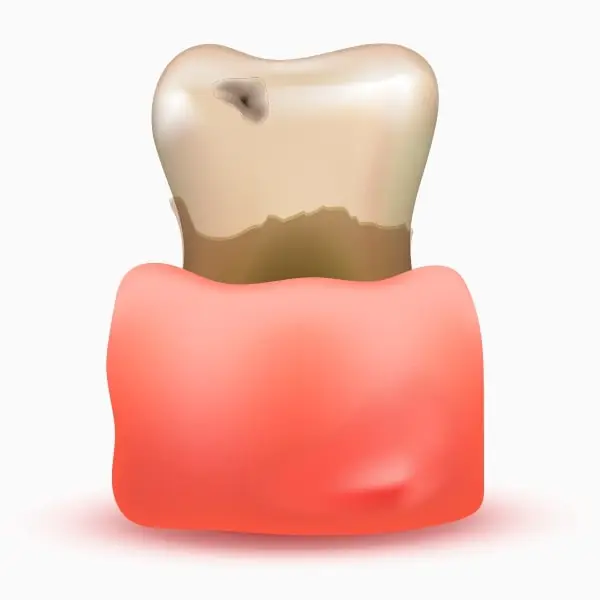Tooth erosion is the gradual wearing away of tooth enamel, the hard outer surface of teeth. It can be caused by many factors, including acid wear from foods and drinks, plaque accumulation, and chemical erosion from tobacco and other drugs. Tooth erosion can lead to cavities and even the loss of teeth if left untreated. Searching for “Erosion Specialist Near Me” or “Treatment for Dental Erosion”? Don't worry, you are at the right place. Magnum Dental Clinic in Dubai is one of the most popular for its dental care and treatment.

Tooth erosion: Tooth erosion is a dental condition that results when acids wear away the tooth's enamel, It’s a chemical loss of mineralized tooth surface caused by acid dissolution of dental hard tissue.
Enamel is the protective outer layer of the tooth that helps to keep bacteria and food from damaging the underlying dentin. When enamel is lost, the dentin is exposed and can become infected or discolored.
Tooth erosion is the gradual loss of tooth enamel, which is the hard outer layer that protects the teeth. Several factors can contribute to tooth erosion, including:
1. Eating and drinking Acidic foods and beverages can cause the enamel on your teeth to wear away.
2. Chronic dry mouth- As inadequate amounts of saliva are produced, teeth are exposed to higher levels of acidity, which damage enamel.
3. GERD – ACID REFLUX –exposes tooth enamel to highly damaging stomach acid
4. Certain medications can cause dry mouth Bite abnormalities and bruxism
6. Poor oral hygiene, using tobacco products, or brushing teeth too vigorously.
7. Ageing
8. Genetics- Individuals who have naturally thinner tooth enamel are more likely to experience erosion
Tooth erosion can be classified into different types based on the underlying causes. The two main types of tooth erosion are:
1. Intrinsic: caused by acids produced from inside the teeth.
2. Extrinsic: caused by acids from outside the teeth.
Erosive wear of the enamel is caused by contact between acidic foods or drinks and the teeth. Each type of erosion can cause different levels of damage to the teeth.
The procedure for tooth erosion treatment involves the use of a dental restoration to rebuild the tooth enamel that has been lost. Tooth enamel erosion and restoration can be a dental filling, crown, or veneer, depending on the severity of the erosion. If the erosion is only on the surface of the tooth, a dental filling may be sufficient. If the erosion is more severe, a dental crown or veneer may be needed. Treatment for tooth enamel erosion is done at Magnum Clinic by experts at the best price.
Tooth erosion is a condition that results when the hard tissues of the teeth are worn away. This can happen when the teeth are exposed to acids over time. The acids can come from many sources, such as foods and drinks, plaque, and even the air. If left untreated, tooth erosion can lead to cavities and even the loss of teeth. Treatment and repair of tooth erosion may include special dental procedures or medications to help protect the teeth from further damage.
If tooth erosion is not addressed, it can lead to a variety of dental problems, including cavities, tooth sensitivity, and even tooth loss. Tooth erosion can be caused by a number of factors, such as consuming sugary drinks or acidic foods, grinding your teeth, or using tobacco products. If left untreated, tooth erosion can cause significant damage to your teeth and may require expensive dental treatment.
The cost of a tooth erosion treatment in Dubai can vary depending on the severity of the tooth erosion and the type of treatment used. Treatment may involve a combination of therapies such as topical fluoride, dental sealants, and dietary changes. In some cases, more extensive treatments such as dental crowns or Dental Veneers may be required. enamel erosion treatment costs.
After your tooth enamel erosion treatment and restoration, it is important to follow the post-treatment care instructions to help protect your teeth from further erosion.
1. Avoid eating or drinking anything acidic for at least an hour after your treatment
2. Avoid brushing your teeth for at least an hour after treatment. Instead, you can rinse your mouth with warm water.
3. When you are ready to brush your teeth, use a soft toothbrush and a gentle circular motion
















Looking for a dental clinic near me? From routine check-ups to advanced treatments, our dental specialists are dedicated to providing exceptional dental care in Dubai.
